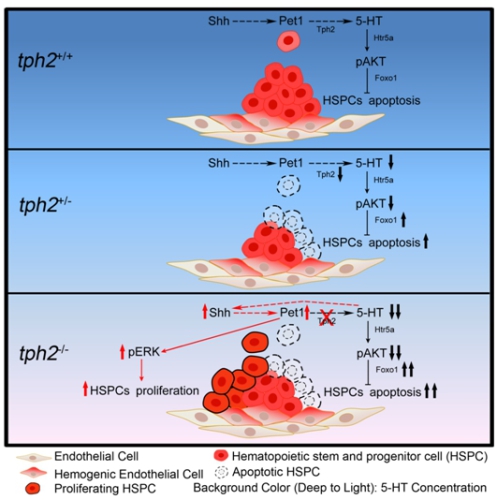Hematopoietic stem and progenitor cells (HSPCs) possess the capacity to produce more than 10 different functional specialized cell lineages, as well as the ability to self-renew. HSPC transplantation is the foundation to treat hematological diseases; however, the lack of HSPC donors greatly limits its wide application. Therefore, a better understanding of HSPC development in vivo may provide insights for potential generation of transplantable HSPCs in vitro for clinical use. Despite decades of efforts, the molecular mechanisms controlling HSPC development remain incompletely understood.
The Hematopoiesis and Cardiovascular Development Group led by Prof. Feng Liu identifies 5-hydroxytryptamine (5-HT, also called serotonin) as a novel endogenous regulator of HSPC development. 5-HT can enhance the colony formation ability of HSPCs in vitro. A decrease of 5-HT synthesized in the aorta-gonad-mesonephros (AGM) of tph2+/- and pet1-cre;tph2+/fl embryos leads to the impairment of HSPCs development and reconstitution ability in the recipients. Further analysis in vec-cre;tph2+/fl embryos shows 5-HT synthesized in the endothelial cells is also important for HSPCs development. Mechanistically, we found that 5-HT inhibits the AKT-Foxo1 signaling cascade to protect the earliest HSPCs in intra-aortic hematopoietic cluster (IAHC) from excessive apoptosis. This process is mediated by Htr5a, a 5-HT receptor. Finally and unexpectedly, we noticed that HSPC development is relatively normal in tph2-/- and pet1-cre;tph2fl/fl embryos, although the excessive apoptosis of HSPCs remains. We further showed that the Nkx2.2-Lmx1b-Pet1 cascade and the upstream Shh signaling are up-regulated in tph2-/- embryos, which in turn re-activates Pet1-ERK signaling. This activated ERK signaling in tph2-/- embryos promotes the proliferation of hematopoietic clusters, and therefore partially restores the defective HSPC development observed in tph2+/- embryos.
In summary, our results demonstrate that 5-HT, which is synthesized in the AGM, acts as a novel endogenous regulator of HSPC development and promotes the survival of HSPCs in the intra-aortic hematopoietic cluster (IAHC) through the AKT-Foxo1 signaling in mice. This reveals the role of 5-HT in HSPC development and suggests that 5-HT signaling may be a potential therapeutic target for promoting HSPC survival.


